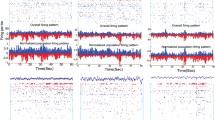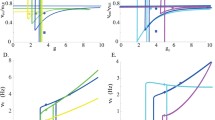Abstract
Within the appropriate parameter regime, a deterministic model of a pair of mutually inhibitory neurons receiving excitatory driving currents exhibits bistability—each of the two stable states corresponds to one neuron being active and the other being quiescent. The presence of noise in the driving currents results in a system that randomly switches back and forth between these two states, causing alternating bouts of spiking activity. In this work, we examine the random bout durations of the two neurons and dependence on system parameters. We find that bout durations of each neuron are exponentially distributed, with changes in system parameters altering only the mean of the distribution. Synaptic inhibition independently controls the bout durations of the two neurons—the mean bout time of a neuron is a function of efferent (or outgoing) inhibition, and is independent of afferent (or incoming) inhibition. Furthermore, we find that the mean bout time of a neuron exhibits a critical dependence on the time course (rather than amplitude) of efferent inhibition—mean bout time of a neuron grows exponentially with the time course of efferent inhibition, and the growth rate of this exponential function depends only on the excitatory driving current to that neuron (and not on any other system parameters). We discuss the relevance of our results to the regulation of sleep-wake cycling by medullary and pontine structures within the brain.











Similar content being viewed by others
References
Behn, C., & Booth, V. (2011). Modeling the temporal architecture of rat sleep-wake behavior. In Engineering in medicine and biology society, EMBC, 2011 annual international conference of the IEEE (pp. 4713–4716). IEEE.
Behn, C., Kopell, N., Brown, E., Mochizuki, T., Scammell, T. (2008). Delayed orexin signaling consolidates wakefulness and sleep: physiology and modeling. Journal of Neurophysiology, 99(6), 3090–3103.
Blumberg, M., Seelke, A., Lowen, S., Karlsson, K. (2005). Dynamics of sleep-wake cyclicity in developing rats. Proceedings of the National Academy of Sciences of the United States of America, 102(41), 14860.
Borbély, A., Achermann, P., Trachsel, L., Tobler, I. (1989). Sleep initiation and initial sleep intensity: interactions of homeostatic and circadian mechanisms. Journal of Biological Rhythms, 4(2), 37–48.
Chu-Shore, J., Westover, M., Bianchi, M. (2010). Power law versus exponential state transition dynamics: application to sleep-wake architecture. PLoS ONE, 5(12), e14204.
Elson, R., Selverston, A., Abarbanel, H., Rabinovich, M. (2001). Inhibitory synchronization of bursting in biological neurons: dependence on synaptic time constant. Journal of Neurophysiology, 88, 1166–1176.
Gall, A., Joshi, B., Best, J., Florang, V.R., Doorn, J.A., Blumberg, M. (2009). Developmental emergence of power-law wake behavior depends upon the functional integrity of the locus coeruleus. Sleep, 32(7), 920–926.
Halász, P., Terzano, M., Parrino, L., Bódizs, R. (2004). The nature of arousal in sleep. Journal of Sleep Research, 13(1), 1–23.
Jalil, S., Belykh, I., Shilnikov, A. (2010). Fast reciprocal inhibition can synchronize bursting neurons. Physical Review. E, Statistical, Nonlinear, and Soft Matter Physics, 81, 045201.
Joshi, B. (2009). A doubly stochastic poisson process model for wake-sleep cycling. Ph.D. thesis, The Ohio State University.
Karlsson, K., Kreider, J., Blumberg, M. (2004). Hypothalamic contribution to sleep-wake cycle development. Neuroscience, 123(2), 575–582.
Karlsson, K., Gall, A., Mohns, E., Seelke, A., Blumberg, M. (2005). The neural substrates of infant sleep in rats. PLoS Biology, 3(5), e143.
Kirillov, A., Myre, C., Woodward, D. (1993). Bistability, switches and working memory in a two-neuron inhibitory-feedback model. Biological Cybernetics, 68, 441–449.
Kleitman, N., & Engelmann, T. (1953). Sleep characteristics of infants. Journal of Applied Physiology, 6(5), 269–282.
Lo, C., Nunes Amaral, L., Havlin, S., Ivanov, P., Penzel, T., Peter, J., Stanley, H. (2002). Dynamics of sleep-wake transitions during sleep. EPL (Europhysics Letters), 57, 625.
Lo, C., Chou, T., Penzel, T., Scammell, T., Strecker, R., Stanley, H., Ivanov, P. (2004). Common scale-invariant patterns of sleep–wake transitions across mammalian species. Proceedings of the National Academy of Sciencesof the United States of America, 101(50), 17545.
Lu, J., Sherman, D., Devor, M., Saper, C. (2006). A putative flip-flop switch for control of rem sleep. Nature, 441(7093), 589–594.
Ostojic, S. (2011). Interspike interval distributions of spiking neurons driven by fluctuating inputs. Journal of Neurophysiology, 106(1), 361–373.
Phillips, A., Robinson, P., Kedziora, D., Abeysuriya, R. (2010). Mammalian sleep dynamics: how diverse features arise from a common physiological framework. PLoS Computational Biology, 6(6), e1000826.
Rempe, M., Best, J., Terman, D. (2010). A mathematical model of the sleep/wake cycle. Journal of Mathematical Biology, 60(5), 615–644.
Robinson, P., Phillips, A., Fulcher, B., Puckeridge, M., Roberts, J. (2011). Quantitative modelling of sleep dynamics. Philosophical Transactions of the Royal Society A: Mathematical Physical and Engineering Sciences, 369(1952), 3840–3854.
Rowat, P., & Selverston, A. (1997). Oscillatory mechanisms in pairs of neurons connected with fast inhibitory synapses. Journal of Computational Neuroscience, 4, 103–127.
Skinner, F., Kopell, N., Marder, E. (1994). Mechanisms for oscillation and frequency control in reciprocally inhibitory model neural networks. Journal of Computational Neuroscience, 1, 69–87.
Tao, L., Shelley, M., McLaughlin, D., Shapley, R. (2004). An egalitarian network model for the emergence of simple and complex cells in visual cortex. Proceedings of the National Academy of Sciences, 101, 366–371.
Terman, D., Kopell, N., Bose, A. (1998). Dynamics of two mutually coupled slow inhibitory neurons. Physica D, 117, 241–275.
Van Vreeswijk, C., Abbott, L., Ermentrout, G. (1994). When inhibition not excitation synchronizes neural firing. Journal of Computational Neuroscience, 1, 313–321.
Wang, X., & Rinzel, J. (1992). Alternating and synchronous rhythms in reciprocally inhibitory model neurons. Neural Computation, 4, 84–97.
Acknowledgments
Mainak Patel was supported by a National Science Foundation grant (DMS-0943760). Badal Joshi was partially supported by a National Science Foundation grant (EF-1038593). We would like to thank the editor and the two anonymous reviewers for their comments and in helping to improve the manuscript. We would also like to thank Mark Blumberg and Janet Best for their insights and comments.
Conflict of interest
The authors declare that they have no conflicts of interest.
Author information
Authors and Affiliations
Corresponding author
Additional information
Action Editor: Bard Ermentrout
Rights and permissions
About this article
Cite this article
Patel, M., Joshi, B. Switching mechanisms and bout times in a pair of reciprocally inhibitory neurons. J Comput Neurosci 36, 177–191 (2014). https://doi.org/10.1007/s10827-013-0464-6
Received:
Accepted:
Published:
Issue Date:
DOI: https://doi.org/10.1007/s10827-013-0464-6




